Impact of Soil Fertilized with Biomass Ash on Depth-Related Variability of Culturable Bacterial Diversity and Selected Physicochemical Parameters in Spring Barley Cultivation
Abstract
1. Introduction
2. Materials and Methods
2.1. Experiment Model
2.2. Soil Sampling and Preparation for Analysis
2.3. Statistic Analysis
2.4. Microbiological Analysis
2.4.1. Soil Preparation for Microbial Analyses
2.4.2. Mass Spectrometry Isolate Identification
3. Results and Discussion
3.1. Effect of Weather Conditions on Soil Moisture
3.2. Bulk Density
3.3. Soil pH
3.4. Microorganisms
4. Conclusions
Supplementary Materials
Author Contributions
Funding
Institutional Review Board Statement
Informed Consent Statement
Data Availability Statement
Conflicts of Interest
References
- Madsen, E.L. Identifying Microorganisms Responsible for Ecologically Significant Biogeochemical Processes. Nat. Rev. Microbiol. 2005, 3, 439–446. [Google Scholar] [CrossRef] [PubMed]
- Grandy, A.S.; Neff, J.C. Molecular C Dynamics Downstream: The Biochemical Decomposition Sequence and its Impact on Soil Organic Matter Structure and Function. Sci. Total Environ. 2008, 404, 297–307. [Google Scholar] [CrossRef]
- Plaza, C.; Courtier-Murias, D.; Fernández, J.M.; Polo, A.; Simpson, A.J. Physical, Chemical, and Biochemical Mechanisms of Soil Organic Matter Stabilization under Conservation Tillage Systems: A Central Role for Microbes and Microbial by-products in C Sequestration. Soil Biol. Biochem. 2013, 57, 124–134. [Google Scholar] [CrossRef]
- Naylor, D.; McClure, R.; Jansson, J. Trends in Microbial Community Composition and Function by Soil Depth. Microorganisms 2022, 10, 540. [Google Scholar] [CrossRef]
- Liu, D.; An, S.S.; Cheng, Y.; Keiblinger, K.; Huang, Y.M. Variability in Soil Microbial Biomass and Diversity Among Different Aggregate-size Fractions of Different Land use Types. Soil Sci. 2014, 179, 242–249. [Google Scholar] [CrossRef]
- Feng, H.; Guo, J.; Wang, W.; Song, X.; Yu, S. Soil Depth Determines the Composition and Diversity of Bacterial and Archaeal Communities in a Poplar Plantation. Forests 2019, 10, 550. [Google Scholar] [CrossRef]
- Tian, Q.; Jiang, Q.; Huang, L.; Lin, Q.; Tang, Z.; Liu, F. Vertical Distribution of Soil Bacterial Communities in Different Forest Types Along an Elevation Gradient. Microb. Ecol. Soil Microbiol. 2022, 174, 7. [Google Scholar] [CrossRef]
- Zhang, M.; Muhammad, R.; Zhang, L.; Xia, H.; Cong, M.; Jiang, C. Investigating the Effect of Biochar and Fertilizer on the Composition and Function of Bacteria in Red Soil. Appl. Soil Ecol. 2019, 139, 107–116. [Google Scholar] [CrossRef]
- Mundra, S.; Kjønaas, O.J.; Morgado, L.N.; Krabberød, A.K.; Ransedokken, Y.; Kauserud, H. Soil Depth Matters: Shift in Composition and Inter-Kingdom Co-Occurrence Patterns of Microorganisms in Forest Soils. FEMS Microbiol. Ecol. 2021, 97, fiab022. [Google Scholar] [CrossRef] [PubMed]
- Gajda, A.; Martyniuk, S. Microbial Biomass C and N and Activity of Enzymes in Soil Under Winter Wheat Grown in Different Crop Management Systems. Pol. J. Environ. Stud. 2005, 14, 159–163. [Google Scholar]
- Gajda, A.M.; Czyż, E.A.; Dexter, A.R.; Furtak, K.M.; Grządziel, J.; Stanek-Tarkowska, J. Effects of Different Soil Management Practices on Soil Properties and Microbial Diversity. Int. Agrophys. 2018, 32, 81–91. [Google Scholar] [CrossRef]
- Gajda, A.M.; Czyż, E.A.; Klimkowicz-Pawlas, A. Effects of Different Tillage Intensities on Physicochemical and Microbial Properties of a Eutric Fluvisol Soil. Agronomy 2021, 11, 1497. [Google Scholar] [CrossRef]
- Saikia, R.; Sharma, S.; Thind, H.S.; Singh, Y. Tillage and Residue Management Practices Affect Soil Biological Indicators in a Rice-Wheat Cropping System in North-Western India. Soil Use Manag. 2019, 36, 157–172. [Google Scholar] [CrossRef]
- Jiang, X.; Wright, A.L.; Wang, J.; Li, Z. Long-term Tillage Effects on the Distribution Patterns of Microbial Biomass and Activities Within Soil Aggregates. Catena. 2011, 87, 276–280. [Google Scholar] [CrossRef]
- Wolińska, A.; Górniak, D.; Zielenkiewicz, U.; Goryluk-Salmonowicz, A.; Kuźniar, A.; Stępniewska, Z.; Błaszczyk, M. Microbial Biodiversity in Arable Soils is Affected by Agricultural Practices. Int. Agrophys. 2017, 31, 259–271. [Google Scholar] [CrossRef]
- Liu, X.; Shi, Y.; Zhang, Q.; Li, G. Effects of Biochar on Nitrification and Denitrification-mediated N2O Emissions and the Associated Microbial Community in an Agricultural Soil. Environ. Sci. Poll. Res. 2021, 28, 6649–6663. [Google Scholar] [CrossRef]
- Bang-Andreasen, T.; Peltre, M.; Ellegaard-Jensen, L.; Hansen, L.H.; Ingerslev, M.; Rønn, R.; Jacobsen, C.S.; Kjøller, R. Application of wood ash leads to strong vertical gradients in soil pH changing prokaryotic community structure in forest top. Soil Sci. Rep. 2021, 11, 742. [Google Scholar] [CrossRef] [PubMed]
- Bang-Andreasen, T.; Nielsen, J.T.; Voriskova, J.; Heise, J.; Rønn, R.; Kjøller, R.; Jacobsen, C.S. Wood Ash Induced PH Changes Strongly Affect Soil Bacterial Numbers and Community Composition. Front. Microbiol. 2017, 8, 1400. [Google Scholar] [CrossRef]
- Stanek-Tarkowska, J.; Pastuszczak, M.; Szpunar-Krok, E.; Kačániová, M.; Kluz, M.I.; Czyż, E.A.; Pieniążek, R.; Skrobacz, K.; Pietrzyk, K. Comparison of the Effect of Fertilization with Ash from Wood Chips on Bacterial Community in Podzolic and Chernozem Soils for the Cultivation of Winter Oilseed Rape: A Preliminary Study. Agronomy 2022, 12, 576. [Google Scholar] [CrossRef]
- Bulgarelli, D.; Schlaeppi, K.; Spaepen, S.; Ver Loren van Themaat, E.; Schulze-Lefert, P. Structure and Functions of the Bacte-rial Microbiota of Plants. Annu. Rev. Plant Biol. 2013, 64, 807–838. [Google Scholar] [CrossRef]
- Zimmermann, S.; Frey, B. Soil Respiration and Microbial Properties in an Acid Forest Soil: Effects of Wood Ash. Soil Biol. Biochem. 2002, 34, 1727–1737. [Google Scholar] [CrossRef]
- Björk, R.G.; Ernfors, M.; Sikström, U.; Nilsson, M.B.; Andersson, M.X.; Rütting, T.; Klemedtsson, L. Contrasting Effects of Wood Ash Application on Microbial Community Structure, Biomass and Processes in Drained Forested Peatlands: Wood Ash Effects on Drained Forested Peatlands. FEMS Microbiol. Ecol. 2010, 73, 550–562. [Google Scholar] [CrossRef] [PubMed]
- Saarsalmi, A.; Smolander, A.; Kukkola, M.; Arola, M. Effect of Wood Ash and Nitrogen Fertilization on Soil Chemical Properties, Soil Microbial Processes, and Stand Growth in Two Coniferous Stands in Finland. Plant Soil 2010, 331, 329–340. [Google Scholar] [CrossRef]
- Moilanen, M.; Silfverberg, K.; Hokkanen, T.J. Effects of Wood-Ash on the Tree Growth, Vegetation and Substrate Quality of a Drained Mire: A Case Study. For. Ecol. Manag. 2002, 171, 321–338. [Google Scholar] [CrossRef]
- Bååth, E.; Arnebrant, K. Growth Rate and Response of Bacterial Communities to PH in Limed and Ash Treated Forest Soils. Soil Biol. Biochem. 1994, 26, 995–1001. [Google Scholar] [CrossRef]
- Fritze, H.; Perkiömäki, J.; Saarela, U.; Katainen, R.; Kim, T.P.; Karp, M.; Haimi, J.; Romantschuk, M. Effect of Cd-Containing Wood Ash on the Microflora of Coniferous Forest Humus. FEMS Microbiol. Ecol. 2000, 32, 43–51. [Google Scholar] [CrossRef]
- Ditzler, C.; Scheffe, K.; Monger, H.C. Soil Science Division Staff. Soil Survey Manual; USDA Handbook 18; Government Printing Office: Washington, DC, USA, 2017; p. 603.
- Lin, C.S.; Binns, M.R.; Voldeng, H.D.; Guillemette, R. Performance of Randomized Block Designs in Field Experiments. Agron. J. 1993, 85, 168–171. [Google Scholar] [CrossRef]
- Nunes, L.J.R.; Matias, J.C.O.; Catalão, J.P.S. Biomass Combustion Systems: A Review on the Physical and Chemical Properties of the Ashes. Renew. Sustain. Energy Rev. 2016, 53, 235–242. [Google Scholar] [CrossRef]
- Strejcek, M.; Smrhova, T.; Junkova, P.; Uhlik, O. Whole-Cell MALDI-TOF MS versus 16S RRNA Gene Analysis for Identification and Dereplication of Recurrent Bacterial Isolates. Front. Microbiol. 2018, 9, 1294. [Google Scholar] [CrossRef] [PubMed]
- Pereira, M.T.J.; Da Silva, T.J.A.; Bonfim-Silva, E.M. Soil Water Content and Wood Ash Fertiliza-Tion on the Cultivation of Gladiolus. Rev. Bras. Eng. Agrícola Ambient. 2016, 20, 350–356. [Google Scholar] [CrossRef][Green Version]
- Li, C.H.; Ma, B.L.; Zhang, T.Q. Soil bulk density effects on soil microbial populations and enzyme activities during the growth of maize (Zea mays L.) planted in large pots under field exposure. Can. J. Soil Sci. 2002, 82, 147–154. [Google Scholar] [CrossRef]
- Hakansson, I.; Lipiec, J. A Review of the Usefulness of Relative Bulk Density Values in Studies of Soil Structure and Compaction. Soil Tillage Res. 2000, 53, 71–85. [Google Scholar] [CrossRef]
- Lipiec, J.; Arvidsson, J.; Murer, E. Review of Modeling Crop Growth, Movement of Water and Chemicals in Relation to Topsoil and Subsoil Compaction. Soil Till. Res. 2003, 73, 15–29. [Google Scholar] [CrossRef]
- Assouline, S. Modelling the Relationship between Soil Bulk Density and the Water Retention Curve. Vadose Zone J. 2006, 5, 554–563. [Google Scholar]
- Fuentes, J.P.; Flurry, M.; Bezdicek, D.F. Hydraulic Propertiesin a Silt Loam Soil Under Natural Prairie, Conventional Till, and No-Till. Soil. Sci. Soc. Am. J. 2004, 68, 1679–1688. [Google Scholar] [CrossRef]
- Horn, R.; Smucker, A. Structure Formation and its Consequences for Gas and Water Transport Inunsaturated Arable and Forest Soils. Soil Till. Res. 2005, 82, 5–14. [Google Scholar] [CrossRef]
- Dec, D.; Dörner, J.; Becker-Fazekas, O.; Horn, R. Effect of Bulk Density on Hydraulic Properties of Homogenized and Structured Soils. J. Soil Sc. Plant Nutr. 2008, 8, 1–13. [Google Scholar]
- Buczko, U.; Bens, O.; Hüttl, R.F. Tillage Effects on Hydraulic Properties and Macroporosity in Silty and Sandy Soils. Soil. Sci. Soc. Am. J. 2006, 70, 1998–2007. [Google Scholar] [CrossRef]
- Bonfim-Silva, E.M.; Martinez-Santos, T.; da Silva, T.J.A.; Alves, R.D.d.S.; Pinheiro, E.A.R.; Duarte, T.F. Wood Ash as a Vegetative-Growth Promoter in Soils with Subsurface Compaction. Rev. Bras. Eng. Agric. Ambient. Braz. J. Agric. Environ. Eng. 2022, 26, 258–265. [Google Scholar] [CrossRef]
- Wang, Y.; Gao, H.; Xie, Z.; Zhang, L.; Ma, X.; Peng, P. Effects of Different Agronomic Practices on the Selective Soil Properties and Nitrogen Leaching of Black Soil in Northeast China. Sci. Rep. 2020, 10, 14939. [Google Scholar] [CrossRef] [PubMed]
- Bloom, P.R.; Skyllberg, U. Soil pH and pH Buffering. In Handbook of Soil Sciences: Properties and Processes, 2nd ed.; Huang, P.M., Li, Y., Sumner, M.E., Eds.; CRC Press: Boca Raton, FL, USA, 2012; pp. 14–19. ISBN 9781439803059. [Google Scholar]
- Paul, E.A. Soil Microbiology, Ecology, and Biochemistry; Academic Press: Cambridge, MA, USA, 2014; p. 576. [Google Scholar]
- Balardian, P. Forest microbiome: Diversity, complexity and dynamics. FEMS Microbiol. Rev. 2017, 41, 109–130. [Google Scholar] [CrossRef]
- Cao, H.; Chen, R.; Wang, L.; Jiang, L.; Yang, F.; Zheng, S.; Wang, G.; Lin, X. Soil PH, Total Phosphorus, Climate and Distance Are the Major Factors Influencing Microbial Activity at a Regional Spatial Scale. Sci. Rep. 2016, 6, 25815. [Google Scholar] [CrossRef] [PubMed]
- Marschner, C.P.H.; Yang, R.; Lieberei, D.E. Crowley Soil and Plant Specific Effects on Bacterial Community Composition in the Rhizosphere Soil Biol. Biol. Biochem. 2001, 33, 1437–1445. [Google Scholar] [CrossRef]
- Ramírez, P.B.; Fuentes-Alburquenque, S.; Díez, B.; Vargas, I.; Bonilla, C.A. Soil microbial community responses to labile organic carbon fractions in relation to soil type and land use along a climate gradient. Soil Biol. Biochem. 2020, 141, 107692. [Google Scholar] [CrossRef]
- Borowik, A.; Wyszkowska, J. Soil Moisture as a Factor Affecting the Microbiological and Biochemical Activity of Soil. Plant Soil Environ. 2016, 62, 250–255. [Google Scholar] [CrossRef]
- Iovieno, P.; Bååth, E. Effect of Drying and Rewetting on Bacterial Growth Rates in Soil: Rewetting and Bacterial Growth in Soil. FEMS Microbiol. Ecol. 2008, 65, 400–407. [Google Scholar] [CrossRef] [PubMed]
- Chi, Z.; Wang, W.; Li, H.; Wu, H.; Yan, B. Soil organic matter and salinity as critical factors affecting the bacterial community and function of Phragmites australis dominated riparian and coastal wetlands. Sci. Total Environ. 2021, 762, 143156. [Google Scholar] [CrossRef] [PubMed]
- Kang, E.; Li, Y.; Zhang, X.; Yan, Z.; Wu, H.; Li, M.; Yan, L.; Zhang, K.; Wang, J.; Kang, X. Soil pH and nutrients shape the vertical distribution of microbial communities in an alpine wetland. Sci. Total Environ. 2021, 774, 145780. [Google Scholar] [CrossRef]
- Barberán, A.; Bates, S.T.; Casamayor, E.O.; Fierer, N. Using network analysis to explore co-occurrence patterns in soil microbial communities. ISME J. 2012, 6, 343–351. [Google Scholar] [CrossRef] [PubMed]
- Lauber, C.L.; Hamady, M.; Knight, R.; Fierer, N. Pyrosequencing-based assessment of soil pH as a predictor of soil bacterial community structure at the continental scale. Appl. Environ. Microbiol. 2009, 75, 5111–5120. [Google Scholar] [PubMed]
- Shen, C.; Xiong, J.; Zhang, H.; Feng, Y.; Lin, X.; Li, X.; Liang, W.; Chu, H. Soil pH drives the spatial distribution of bacterial communities along elevation on Changbai Mountain. Soil Biol. Biochem. 2013, 57, 204–211. [Google Scholar] [CrossRef]
- Perkiömäki, J.; Fritze, H. Does Simulated Acid Rain Increase the Leaching of Cadmium from Wood Ash to Toxic Levels to Coniferous Forest Humus Microbes? FEMS Microbiol. Ecol. 2003, 44, 27–33. [Google Scholar] [CrossRef] [PubMed]
- Arnebrant, K. Nitrogen amendments reduce the growth of extramatrical ectomycorrhizal mycelium. Mycorrhiza 1994, 5, 7–15. [Google Scholar] [CrossRef]
- Aronsson, K.A.; Ekelund, N.G.A. Biological Effects of Wood Ash Application to Forest and Aquatic Ecosystems. J. Environ. Qual. 2004, 33, 1595–1605. [Google Scholar] [CrossRef] [PubMed]
- Ashfaq, M.Y.; Da’na, D.A.; Al-Ghouti, M.A. Application of MALDI-TOF MS for Identification of Environmental Bacteria: A Review. J. Environ. Manag. 2022, 305, 114359. [Google Scholar] [CrossRef]
- Zhao, H.; Zhao, Y.; Guo, X.; Wu, N.; Tian, X.; Zhou, S.; Ahmad, S. Effect of Straw and Wood Ash on Soil Carbon Sequestration and Bacterial Community in a Calcareous Soil. Res. Sq. 2021, 13, 926506. [Google Scholar] [CrossRef] [PubMed]
- Demeyer, A.; Voundi Nkana, J.C.; Verloo, M.G. Characteristics of Wood Ash and Influence on Soil Properties and Nutrient Uptake: An Overview. Bioresour. Technol. 2001, 77, 287–295. [Google Scholar] [CrossRef]
- Bang-Andreasen, T.; Anwar, M.Z.; Lanzén, A.; Kjøller, R.; Rønn, R.; Ekelund, F.; Jacobsen, C.S. Total RNA sequencing reveals multilevel microbial community changes and functional responses to wood ash application in agricultural and forest soil. FEMS Microbiol. Ecol. 2020, 96, fiaa016. [Google Scholar] [CrossRef] [PubMed]
- Glick, B.R.; Gamalero, E. Recent Developments in the Study of Plant Microbiomes. Microorganisms 2021, 9, 1533. [Google Scholar] [CrossRef]
- Glick, B.R. Beneficial Plant-Bacterial Interactions, 2nd ed.; Springer: Berlin/Heidelberg, Germany, 2020; p. 383. [Google Scholar]
- Glick, B.R. Plant growth-promoting bacteria: Mechanisms and applications. Scientifica 2012, 2012, 963401. [Google Scholar] [CrossRef]
- Glick, B.R. Bacteria with ACC deaminase can promote plant growth and help to feed the world. Microbiol. Res. 2014, 169, 30–39. [Google Scholar] [CrossRef] [PubMed]
- Olanrewaju, O.S.; Glick, B.R.; Babalola, O.O. Mechanisms of action of plant growth promoting bacteria. World J. Microbiol. Biotechnol. 2017, 33, 197. [Google Scholar] [CrossRef] [PubMed]
- Ali, S.; Glick, B.R. Plant-bacterial interactions in management of plant growth under abiotic stresses. In New and Future Developments in Microbial Biotechnology and Bioengineering; Singh, J.S., Ed.; Elsevier: Amsterdam, The Netherlands, 2019; pp. 21–45. [Google Scholar]
- Gamalero, E.; Glick, B.R. Plant growth-promoting bacteria in agriculture and stressed environments. In Modern Soil Microbiology, 3rd ed.; Van Elsas, J.D., Trevors, J.T., Eds.; CRC Press: Boca Raton, FL, USA, 2019; pp. 361–380. [Google Scholar]
- Vega-Celedón, P.; Bravo, G.; Velásquez, A.; Cid, F.P.; Valenzuela, M.; Ramírez, I.; Vasconez, I.-N.; Álvarez, I.; Jorquera, M.A.; Seeger, M. Microbial Diversity of Psychrotolerant Bacteria Isolated from Wild Flora of Andes Mountains and Patagonia of Chiletowards the Selection of Plant Growth-Promoting Bacterial Consortia to Alleviate Cold Stress in Plants. Microorganisms 2021, 9, 538. [Google Scholar] [CrossRef] [PubMed]
- Ercole, T.G.; Savi, D.C.; Adamoski, D.; Kava, V.M.; Hungria, M.; Galli-Terasawa, L.V. Diversity of maize (Zea mays L.) rhizobacteria with potential to promote plant growth. Braz. J. Microbiol. 2021, 52, 1807–1823. [Google Scholar] [CrossRef] [PubMed]
- Patel, P.; Patel, K.; Dhandhukia, P.; Thakker, J.N. Plant growth promoting traits of marine Micrococcus sp. with bio-control ability against Fusarium in chickpea plant. Vegetos 2021, 34, 94–101. [Google Scholar] [CrossRef]
- Kumar, M.; Charishma, K.; Sahu, K.P.; Sheoran, N.; Patel, A.; Kundu, A.; Kumar, A. Rice leaf associated Chryseobacterium species: An untapped antagonistic Flavobacterium displays volatile mediated suppression of rice blast disease. Biol. Control 2021, 161, 104703. [Google Scholar] [CrossRef]
- Singh, J.S. Biodiversity: Current perspective. Clim. Chang. Environ. Sustain. 2015, 3, 71–72. [Google Scholar] [CrossRef]
- Singh, J.S. Microbes: The chief ecological engineers in reinstating equilibrium in degraded ecosystems. Agric. Ecosyst. Environ. 2015, 203, 80–82. [Google Scholar] [CrossRef]
- Singh, J.S. Plant-microbe interactions: A viable tool for agricultural sustainability. Appl. Soil Ecol. 2015, 92, 45–46. [Google Scholar] [CrossRef]
- Singh, J.S. Microbes play major roles in the ecosystem services. Clim. Chang. Environ. Sustain. 2015, 3, 163–167. [Google Scholar] [CrossRef]
- Singh, J.S. Capping methane emissions. Sci. Rep. 2016, 47, 9, 29–30. [Google Scholar]
- Tiwari, S.; Prasad, V.; Lata, C. Bacillus: Plant Growth Promoting Bacteria for Sustainable Agriculture and Environment. In New and Future Developments in Microbial Biotechnology and Bioengineering: Microbial Biotechnology in Agro-Environmental Sustainability; Elsevier: London, UK, 2019; pp. 43–55. [Google Scholar]
- Nadeem, S.M.; Naveed, M.; Ayyub, M.; Khan, M.Y.; Ahmad, M.; Zahir, Z.A. Potential, limitations and future prospects of Pseudomonas spp. for sustainable agriculture and environment: A Review. Soil Environ. 2016, 35, 106–145. [Google Scholar]
- Grady, E.N.; MacDonald, J.; Liu, L.; Richman, A.; Yuan, Z.C. Current knowledge and perspectives of Paenibacillus: A review. Microb. Cell Factories 2016, 15, 203. [Google Scholar] [CrossRef] [PubMed]
- Ahsan, N.; Shimizu, M. Lysinibacillus Species: Their potential as effective bioremediation, biostimulant, and biocontrol agents. Rev. Agric. Sci. 2021, 9, 103–116. [Google Scholar] [CrossRef]
- Park, M.K.; Park, Y.J.; Kim, M.; Kim, M.C.; Ibal, J.C.; Kang, G.U.; Shin, J.H. Complete genome sequence of a plant growth-promoting bacterium Pseudarthrobacter sp. NIBRBAC000502772, isolated from shooting range soil in the Republic of Korea. Microbiol. Soc. Korea 2020, 56, 390–393. [Google Scholar]
- LeBlanc, J.C.; Gonçalves, E.R.; Mohn, W.W. Global response to desiccation stress in the soil actinomycete Rhodococcus jostii RHA1. Appl. Environ. Microbiol. 2008, 74, 2627–2636. [Google Scholar] [CrossRef] [PubMed]
- Krishnan, R.; Menon, R.R.; Tanaka, N.; Busse, H.-J.; Krishnamurthi, S.; Rameshkumar, N. Arthrobacter pokkalii sp nov, a NovelPlant Associated Actinobacterium with Plant Beneficial Properties, Isolated from Saline Tolerant Pokkali Rice, Kerala, India. PLoS ONE 2016, 11, e0150322. [Google Scholar] [CrossRef]
- Sagar, S.; Dwivedi, A.; Yadav, S.; Tripathi, M.; Kaistha, S.D. Hexavalent chromium reduction and plant growth promotion by Staphylococcus arlettae strain Cr11. Chemosphere 2012, 86, 847–852. [Google Scholar] [CrossRef]
- Jayakumar, A.; Krishna, A.; Nair, I.C.; Radhakrishnan, E.K. Drought-tolerant and plant growth-promoting endophytic Staphylococcus sp. having synergistic effect with silicate supplementation. Arch. Microbiol. 2020, 202, 1899–1906. [Google Scholar] [CrossRef]
- Riva, V.; Terzaghi, E.; Vergani, L.; Mapelli, F.; Zanardini, E.; Morosini, C.; Raspa, G.; Di Guardo, A.; Borin, S. Exploitation of Rhizosphere Microbiome Services. In Methods in Rhizosphere Biology Research; Reinhardt, D., Sharma, A., Eds.; Springer: Singapore, 2019; pp. 105–132. [Google Scholar] [CrossRef]
- Sharma, N.; Saharan, B.S.; Saharan, B.S. Role of Micrococcus luteus SNSr7 strain NH54PC02 in Sustainable agriculture by behaving as Biocontrol agent. Int. J. Microbiol. Allied Sci. 2016, 3, 1–13. [Google Scholar]
- Manter, D.K.; Delgado, J.A.; Holm, D.G.; Stong, R.A. Pyrosequencing reveals a highly diverse and cultivar-specific bacterial endophyte community in potato roots. Microb. Ecol. 2010, 60, 157–166. [Google Scholar] [CrossRef] [PubMed]
- Sang, M.K.; Kim, K.D. The volatile-producing Flavobacterium johnsoniae strain GSE09 shows biocontrol activity against Phytophthora capsici in pepper. J. Appl. Microbiol. 2012, 113, 383–398. [Google Scholar] [CrossRef] [PubMed]
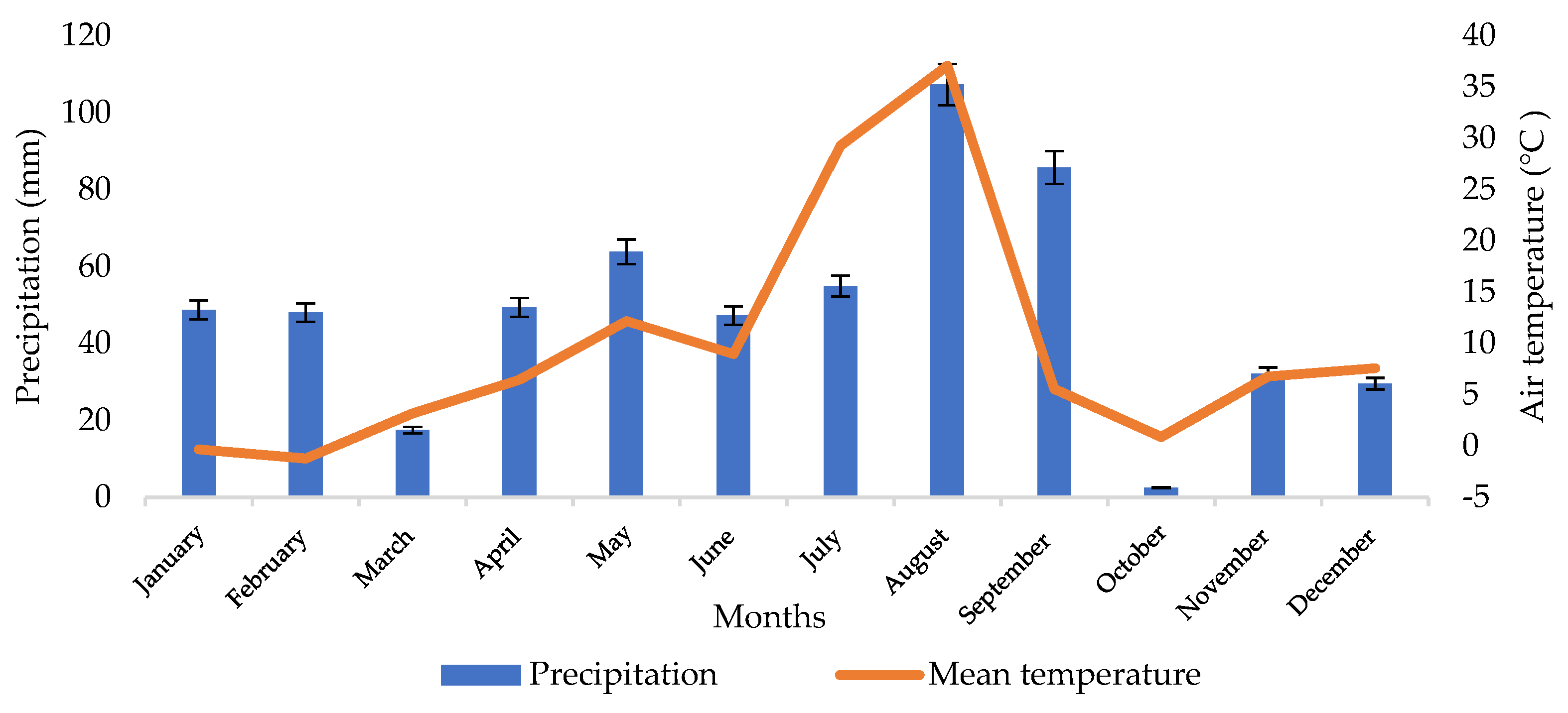
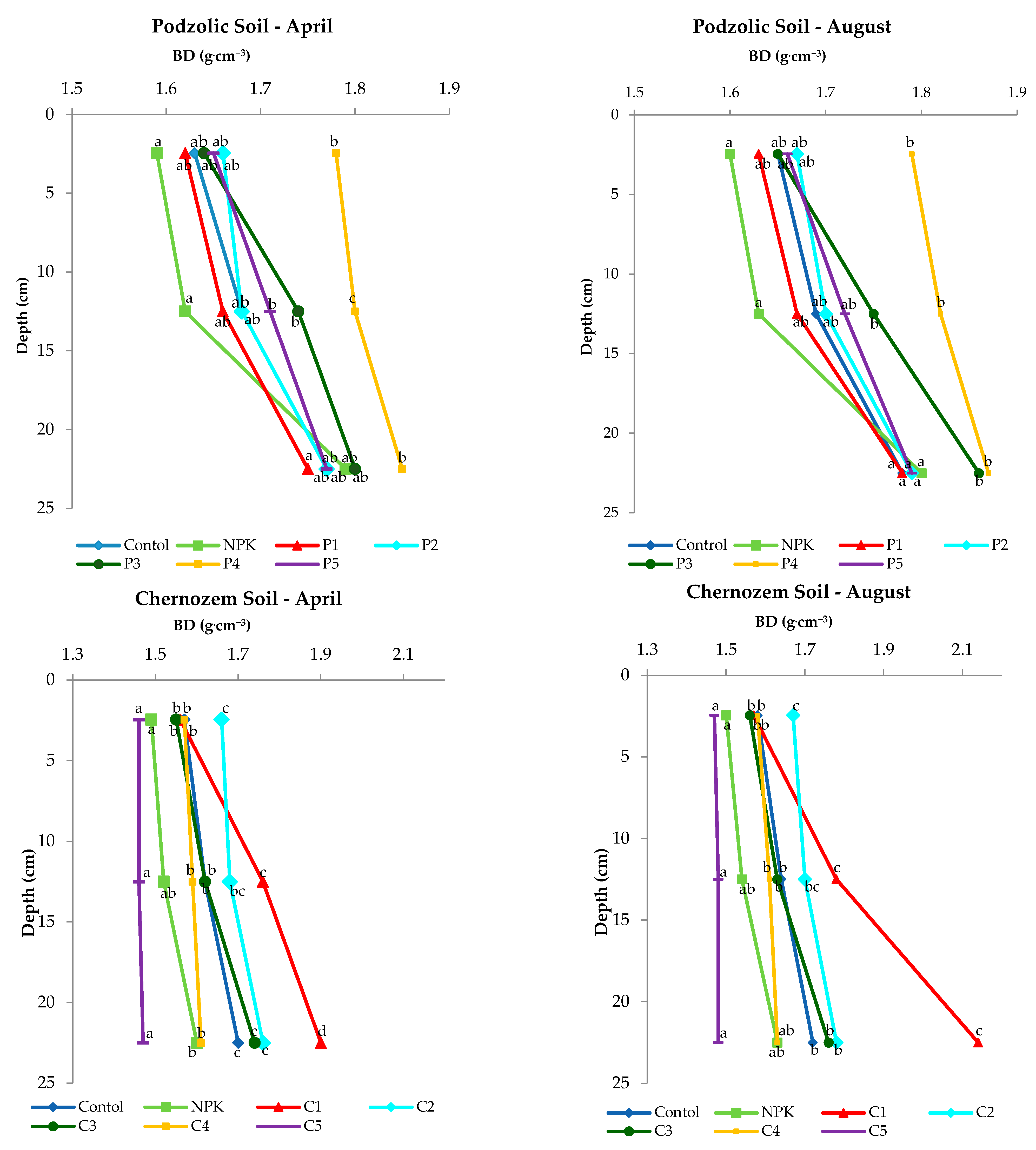
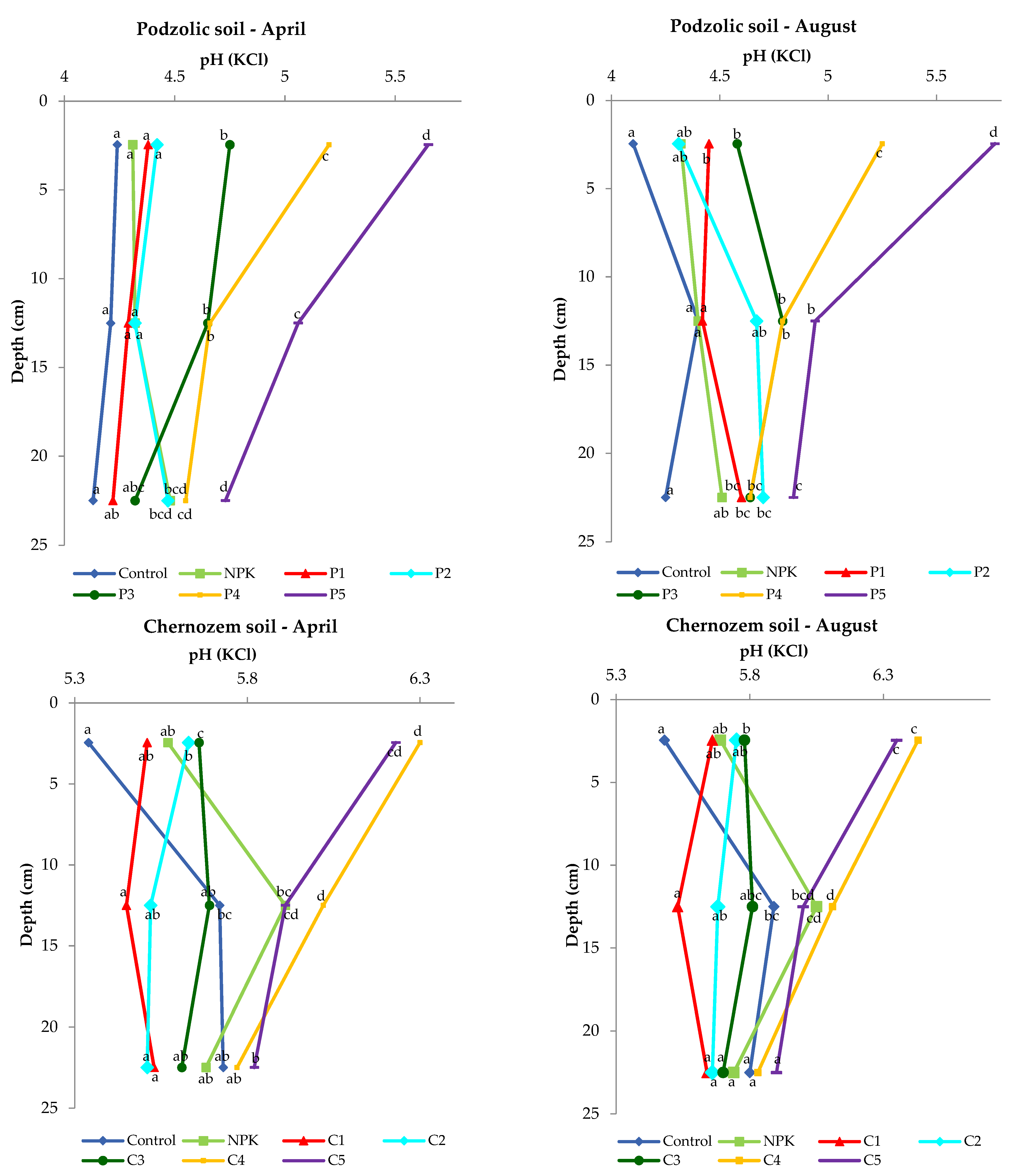
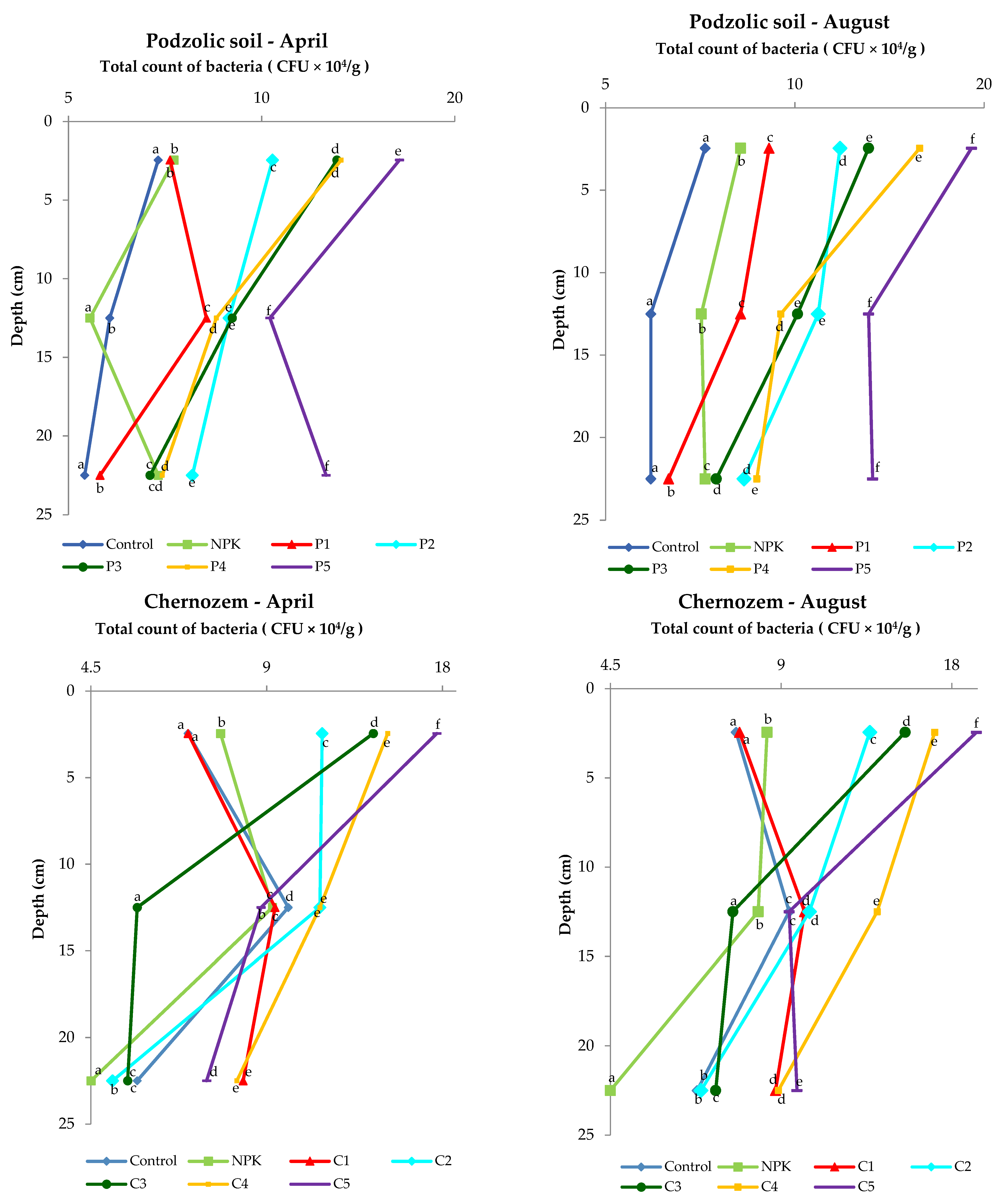
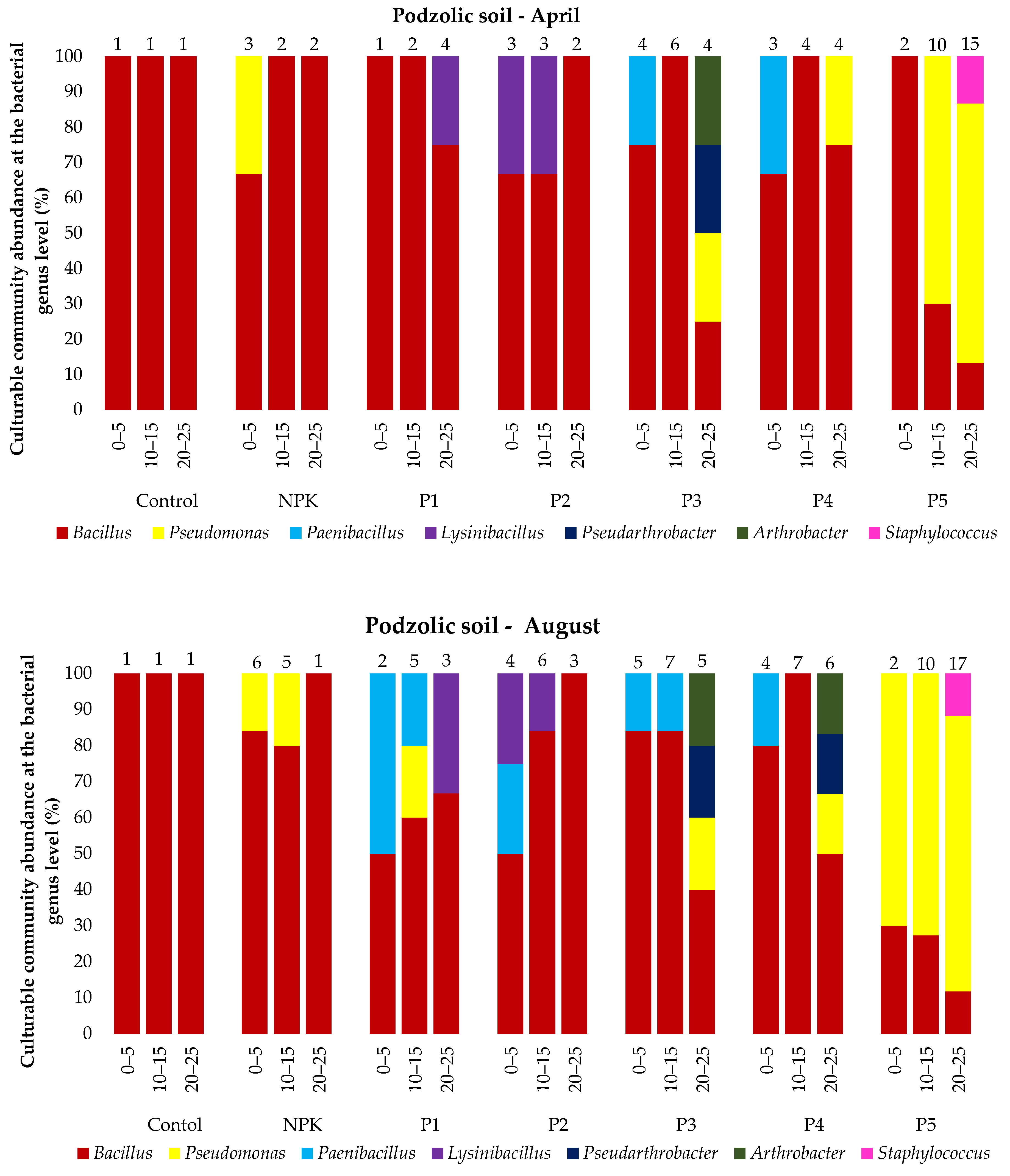
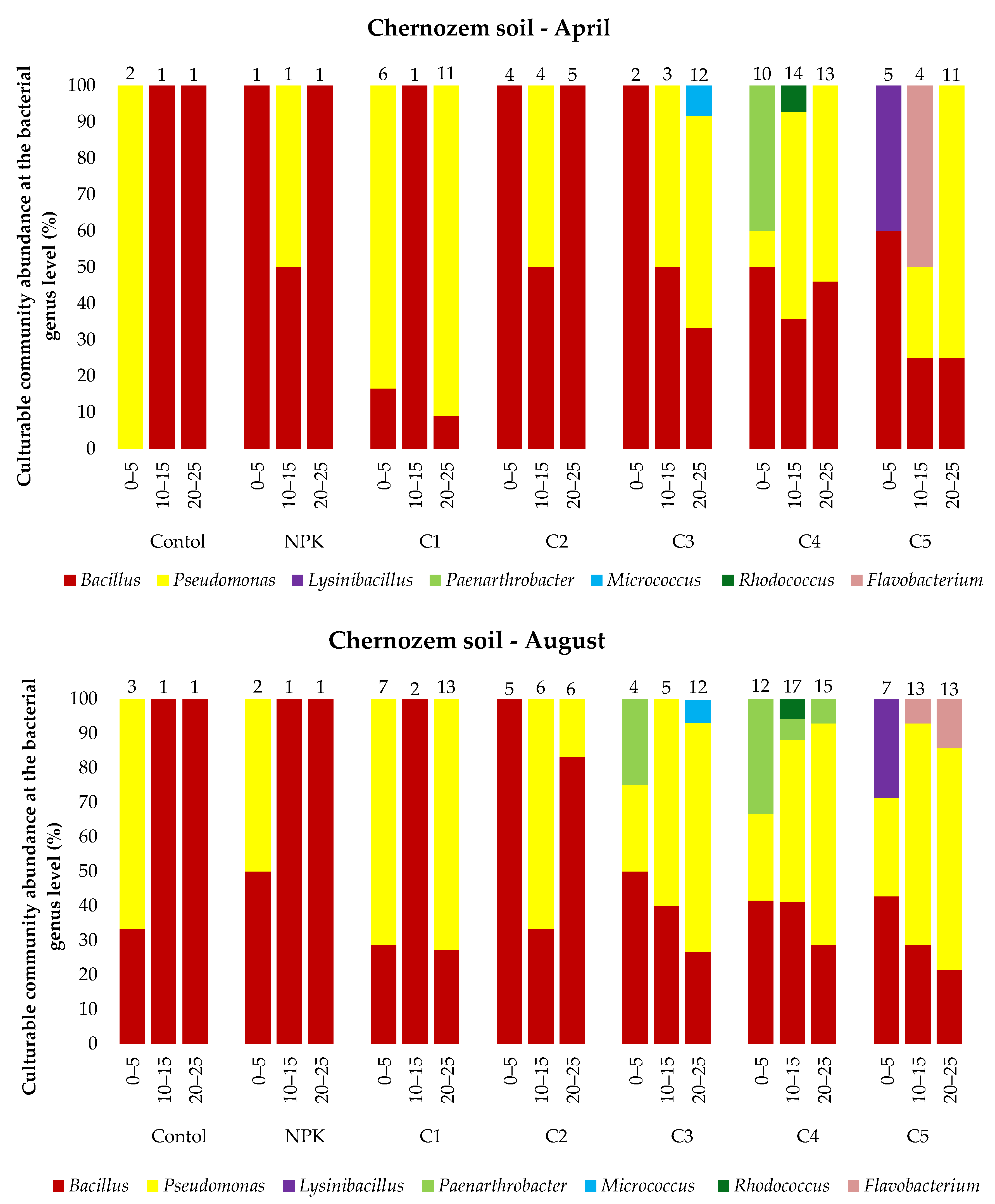
| Composition of Biomass Ash Used in the Experiment for Fertilization of Winter Oilseed Rape on Podzolic Soil and Chernozem | ||||||
| pH H2O | EC µS·cm−1 | Ca (mg kg−1) | K (mg kg−1) | Na (mg kg−1) | P (mg kg−1) | |
| 12.82 | 8.81 | 145.081 | 129.617 | 1452 | 9244 | |
| Fertilizers used in the two field experiments in 2018–2021 podzolic soil and chernozem | ||||||
| Fertilizer-Trade Name | Amount of Pure Component in 100 kg of the Fertilizer | Dose (kg/L per 1 ha) | Date of Application | |||
| Fertilizer | Pure Component | |||||
| Biomass combustion ash | 1.63 %P (3,73 kg P), 19.4% K (23.37 kg K), 4.96% Mg (8.222 kg Mg) | Varied depending on the experimental variant | 30 August 2018 29 August 2019 25 August 2020 | |||
| Monoammonium phosphate (MAP) NH4H2PO4 (12%N-NH4, 52% P2O5, 22.7% P) | 22.7 kg P | 150 | 34 | 30 August 2018 (all variants) 29 August 2019 (all variants) 25 August 2020 (all variants) | ||
| 12 kg N | 18 | |||||
| Potassium salt (60%) | 60 kg K | 175 | 105 | 30 August 2018 (NPK variant only) 29 August 2019 (NPK variant only) 28 August 2020 (NPK variant only) | ||
| RSM ® 32% N (aqueous solution of urea-ammonium nitrate, density 1.32 kg/dcm3) | 42.2 kg N (32 × 1.32) | 150 | 63.3 | 4 March 2019 10 March 2020 15 March 2021 | ||
| Depth (cm) | Control | NPK | P1 | P2 | P3 | P4 | P5 |
|---|---|---|---|---|---|---|---|
| April | |||||||
| 0–5 | 28.1 a | 31.15 b | 33.01 bc | 34.31 cd | 34.76 cd | 35.91 d | 36.46 d |
| 10–15 | 29.05 a | 30.01 a | 31.12 a | 31.54 a | 35.94 b | 36.35 b | 37.25 b |
| 20–25 | 23.26 a | 24.12 ab | 25.69 ab | 26.18 bc | 28.9 cd | 30.14 d | 31.12 d |
| August | |||||||
| 0–5 | 21.01 a | 21.05 a | 22.99 ab | 22.75 ab | 25.21 bc | 25.3 bc | 26.65 c |
| 10–15 | 26.78 a | 27.53 ab | 27.76 abc | 28.95 abc | 29.4 abc | 30.17 bc | 30.51 c |
| 20–25 | 28.03 a | 29.02 ab | 29.56 ab | 30.07 abc | 31.03 bc | 31.51 bc | 32.52 c |
| Depth (cm) | Control | NPK | C1 | C2 | C3 | C4 | C5 |
|---|---|---|---|---|---|---|---|
| April | |||||||
| 0–5 | 31.46 a | 32.12 a | 32.71 a | 35.61 b | 36.39 b | 36.96 b | 37.74 b |
| 10–15 | 32.98 a | 33.1 a | 33.15 a | 37.12 b | 37.96 b | 38.52 b | 39.05 b |
| 20–25 | 33.25 a | 34.58 a | 35.98 ab | 37.75 bc | 38.08 bc | 39.12 c | 39.64 c |
| August | |||||||
| 0–5 | 31.37 a | 32.4 ab | 32.8 abc | 34.51 bcd | 35.49 cd | 35.89 d | 36.57 d |
| 10–15 | 32.3 a | 33.48 a | 34.06 ab | 36.57 bc | 37.19 c | 37.46 c | 38.97 c |
| 20–25 | 33.09 a | 34.39 a | 35.56 ab | 37.67 bc | 38.59 c | 38.88 c | 39.52 c |
Publisher’s Note: MDPI stays neutral with regard to jurisdictional claims in published maps and institutional affiliations. |
© 2022 by the authors. Licensee MDPI, Basel, Switzerland. This article is an open access article distributed under the terms and conditions of the Creative Commons Attribution (CC BY) license (https://creativecommons.org/licenses/by/4.0/).
Share and Cite
Pastuszczak, M.; Stanek-Tarkowska, J.; Kačániová, M. Impact of Soil Fertilized with Biomass Ash on Depth-Related Variability of Culturable Bacterial Diversity and Selected Physicochemical Parameters in Spring Barley Cultivation. Int. J. Environ. Res. Public Health 2022, 19, 13721. https://doi.org/10.3390/ijerph192113721
Pastuszczak M, Stanek-Tarkowska J, Kačániová M. Impact of Soil Fertilized with Biomass Ash on Depth-Related Variability of Culturable Bacterial Diversity and Selected Physicochemical Parameters in Spring Barley Cultivation. International Journal of Environmental Research and Public Health. 2022; 19(21):13721. https://doi.org/10.3390/ijerph192113721
Chicago/Turabian StylePastuszczak, Miłosz, Jadwiga Stanek-Tarkowska, and Miroslava Kačániová. 2022. "Impact of Soil Fertilized with Biomass Ash on Depth-Related Variability of Culturable Bacterial Diversity and Selected Physicochemical Parameters in Spring Barley Cultivation" International Journal of Environmental Research and Public Health 19, no. 21: 13721. https://doi.org/10.3390/ijerph192113721
APA StylePastuszczak, M., Stanek-Tarkowska, J., & Kačániová, M. (2022). Impact of Soil Fertilized with Biomass Ash on Depth-Related Variability of Culturable Bacterial Diversity and Selected Physicochemical Parameters in Spring Barley Cultivation. International Journal of Environmental Research and Public Health, 19(21), 13721. https://doi.org/10.3390/ijerph192113721








